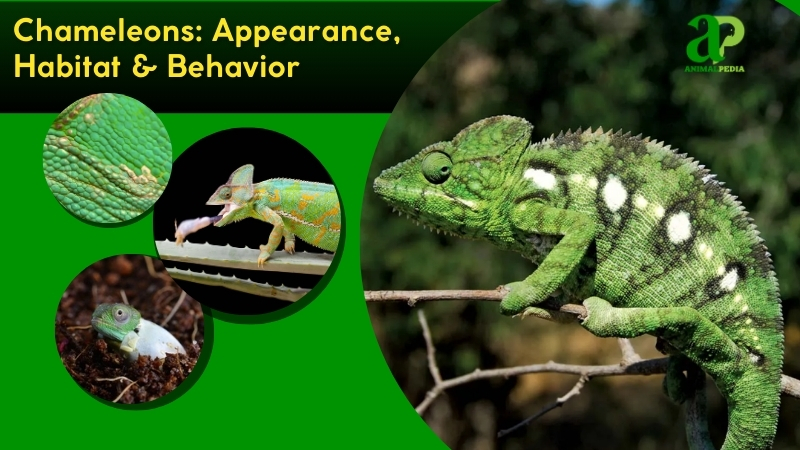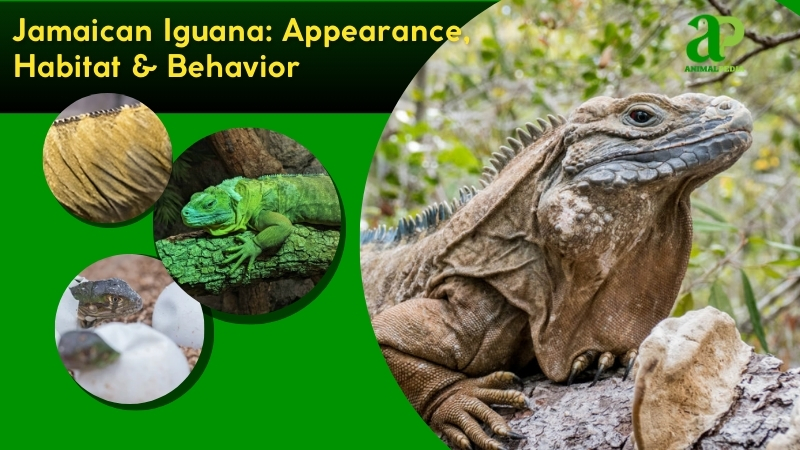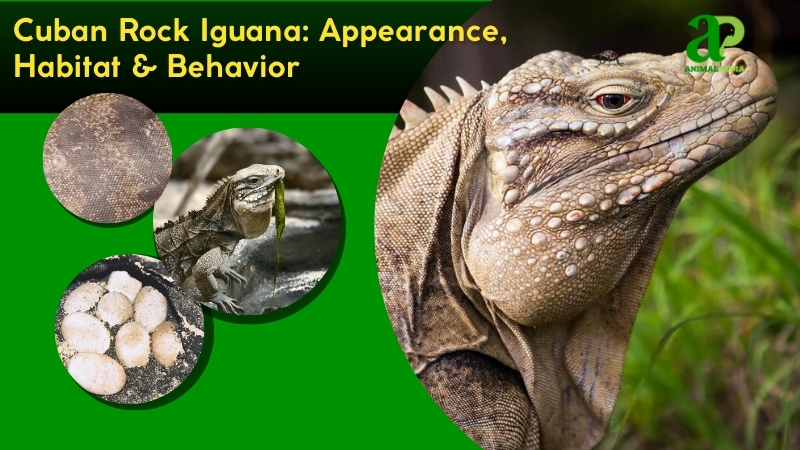Worm lizards, or amphisbaenians, fascinate scientists with their distinct morphology. Over 200 species exist, combining vermiform anatomy with reptilian characteristics. Their elongated, legless bodies feature distinctive ringed scales called annuli. Some species, notably Bipes biporus, retain vestigial forelimbs. Coloration spans pink to dark brown, providing effective substrate camouflage. These fossorial reptiles inhabit North America, Europe, Africa, South America, the Caribbean, and Western Asia. Most species measure under 6 inches (15 cm), though paleontological evidence reveals extinct forms exceeding 3 feet (91 cm).
Several keystone species represent this suborder. Bipes biporus (two-legged worm lizard) inhabits Baja California’s sandy substrates. Amphisbaena alba (red worm lizard) ranges throughout South American tropical zones and Caribbean islands. Blanus cinereus (Iberian worm lizard) occupies the loose soils of Spain and Portugal. Their defining adaptation? Kineticranium—specialized reinforced skulls for subterranean locomotion. The Mexican Bipes typically reaches 7.5–8.3 inches (19–21 cm), while the extinct Terastiodontosaurus marcelosanchezi grew to over 3 feet.
Behavioral ecology characterizes these subterranean hunters. Though not apex predators, they dominate underground trophic niches. They employ ambush predation against arthropods, annelids, and small vertebrates, using their curved bodies to trap prey within tunnels. Larger Amphisbaena species tackle more substantial prey including rodents, utilizing powerful jaws with kinetic biting. Diet composition varies with habitat; human-amphisbaenian interactions minimal due to their cryptic lifestyle.
Reproductive biology occurs exclusively underground. Breeding phenology peaks during warmer months, though specifics vary geographically. Most species are oviparous, laying 1–3 eggs per clutch in specialized soil chambers. Incubation periods span several months, producing precocial hatchlings. Sexual maturity requires multiple years; longevity extends to a decade or more in certain species. Data gaps persist due to their secretive nature and sampling difficulties.
This article explores amphisbaenian morphology, geographic distribution, and behavioral adaptations. It synthesizes contemporary herpetological research with visual documentation, illuminating these enigmatic reptiles for both specialized herpetologists and curious naturalists.
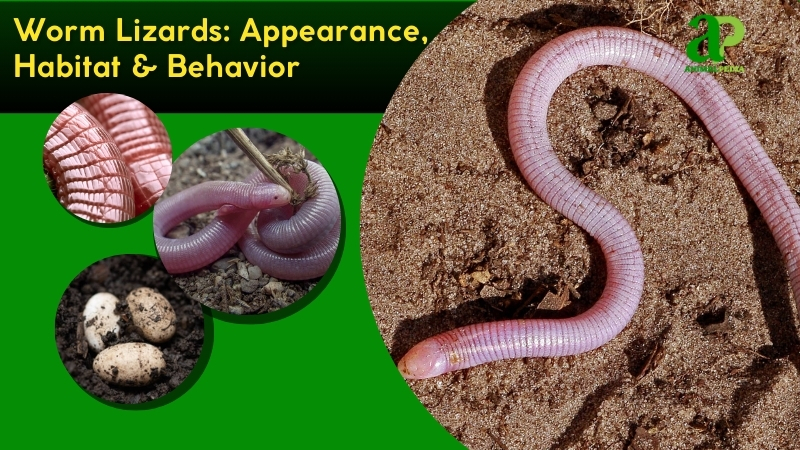
What Do The Worm Lizards Look Like?
Worm lizards, or amphisbaenians, have long, cylindrical bodies resembling earthworms. Over 200 species exist, ranging in color from pale pink to dark brown, helping them blend into underground habitats. Their skin features distinct annular scales arranged in segments, creating a smooth yet durable texture perfect for digging.
Most species measure under 6 inches (15 cm), though ancient relatives like Terastiodontosaurus reached lengths exceeding 3 feet (91 cm). Unlike snakes, these reptiles possess reinforced, rigid skulls specialized for tunneling.
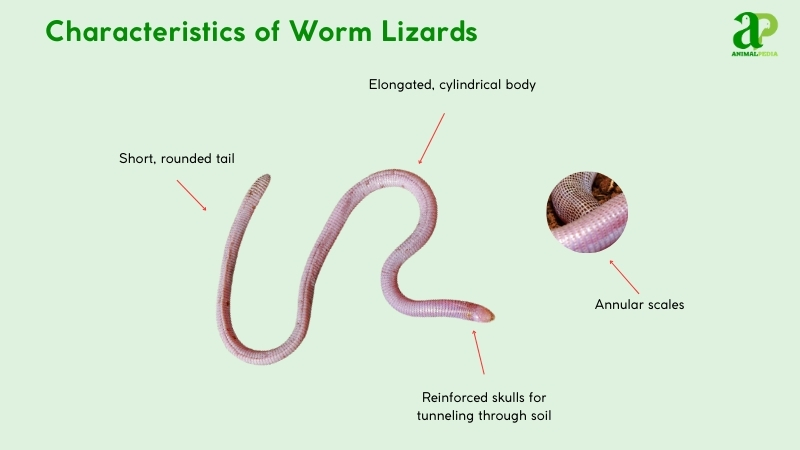
How Big Do Worm Lizards Get?
Worm lizards (Amphisbaenians) are typically small, elongated reptiles, averaging 6 to 12 inches (15–30 cm) in length and weighing under 0.5 pounds (0.23 kg). The largest documented species, Amphisbaena alba, can grow up to 27 inches (70 cm) long and was most notably observed in the Brazilian Cerrado. This species is distinguished in studies such as Gans (2013), who cataloged morphometrics across several Amphisbaenian populations in South America.
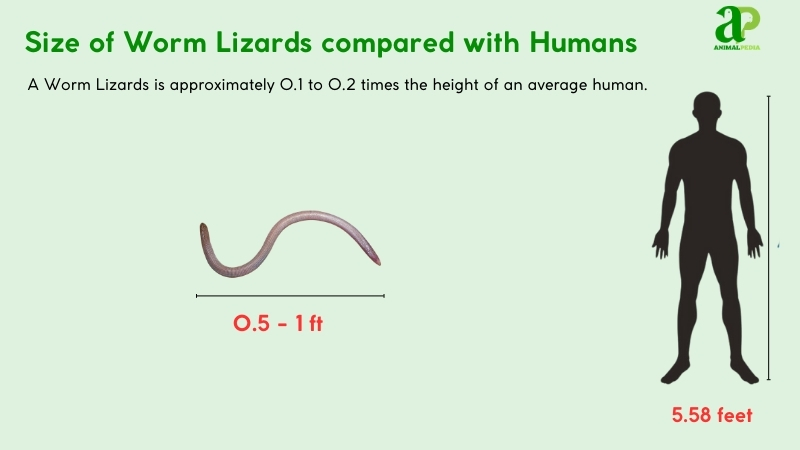
There is moderate sexual dimorphism in some species. Males are often slightly longer and heavier than females, though body width tends to be similar. These differences may relate to reproductive roles and burrowing efficiency.
| Trait | Male | Female |
| Length | 7.1–11.8 in (18–30 cm) | 5.9–9.8 in (15–25 cm) |
| Weight | 0.18–0.26 lbs (80–120 g) | 0.13–0.22 lbs (60–100 g) |
What Are The Unique Physical Characteristics Of The Worm Lizards?
Worm lizards, or amphisbaenians, possess unique physical traits unlike other characteristics of reptiles. Their reinforced skulls form a solid, chisel-like structure, distinguishing them from snakes and legless lizards. This adaptation powers their subterranean lifestyle.
Their annular scales—ringed, overlapping segments—resemble earthworms, uncommon among squamates. Some species, including Bipes biporus, retain tiny forelimbs, absent in most relatives. These distinctive features characterize over 200 species globally.
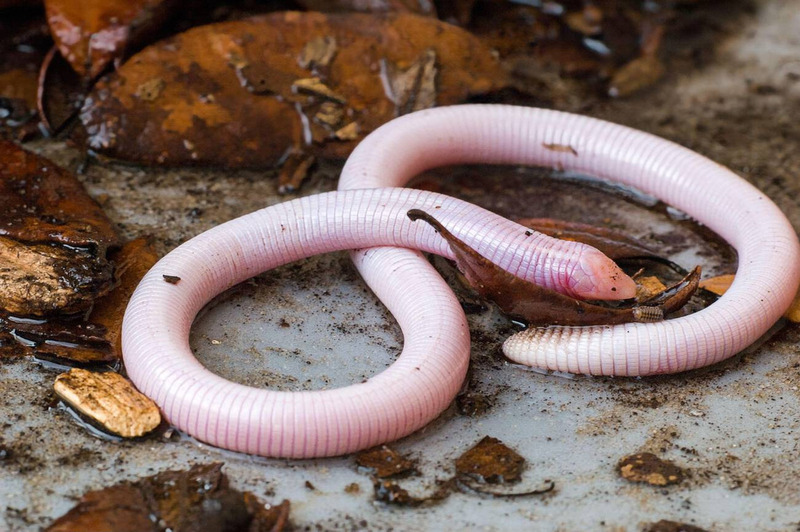
How Do Worm Lizards Adapt With Their Unique Features?
Worm lizards thrive underground with reinforced skulls and annular scales. These traits let them burrow through soil, escape predators, and hunt prey such as worms and insects. The skull, fused and robust, powers tunneling in harsh terrains across continents. Scales, ringed and flexible, shield them as they slide through tight spaces.
Their senses bolster this adaptation. Tiny, vestigial eyes detect light shifts, guiding depth perception. Sensitive skin feels vibrations, alerting them to threats or prey. A keen olfactory system detects food in the dark, enhancing survival. Limited hearing picks up low-frequency rumbles, aiding navigation. Together, these features make worm lizards masters of subterranean life.
Anatomy
Worm lizards, or amphisbaenians, are a unique group of legless reptiles adapted for life beneath the surface. Their anatomy and physiology have evolved to suit a subterranean lifestyle, making them among the most specialized reptiles. With compact bodies and minimal external features, they navigate soil with ease while largely unseen by predators or prey.
- Respiratory System: Simple lungs, often one dominant, handle low-oxygen burrows. Efficient gas exchange supports long tunneling sessions (Meza et al., 2024).
- Circulatory System: The Compact heart pumps blood through a narrow body. High capillary density aids oxygen delivery in tight, soil-bound spaces.
- Digestive System: Short gut processes prey like insects and worms fast. Strong jaws crush food, which suits their ambush-hunting style underground.
- Excretory System: Kidneys conserve water and expel waste through a cloaca. This minimizes hydration needs in dry, arid habitats.
- Nervous System: Reduced eyes link to a basic brain, prioritizing vibration-sensitive skin. This detects prey and threats in dark tunnels.
Together, these internal systems form a finely tuned biological toolkit. Each function supports the worm lizard’s survival in a harsh, competitive world beneath the soil.
How Many Types Of Worm Lizards?
Worm lizards, scientifically known as Amphisbaenians, include over 210 recognized species, classified under 4 living families. These families are: Amphisbaenidae, Bipedidae, Blanidae, and Trogonophidae (Vitt & Caldwell, 2019). Each family varies by skull morphology, body structure, and geographic range.
Taxonomic classification is based on morphological traits and molecular phylogenetics, particularly DNA sequencing of nuclear and mitochondrial genes. The current system follows revisions proposed by Gans (2005) and supported by recent studies (Longrich et al., 2023), focusing on cranial bone structure and limb reduction patterns.
Order: Amphisbaenia
├── Family: Amphisbaenidae (190+ species)
├── Familly: Blanidae (6 species)
├── Family: Trogonophidae (6 species)
└── Family: Bipedidae (1 genus, 3 species)
Amphisbaenidae is the most diverse family, with species spread across South America, Africa, and parts of the Caribbean. Bipedidae, uniquely, includes species with forelimbs—a rare trait among worm lizards. Some extinct families, like Rhineuridae, are known from fossils in North America, further enriching the order’s evolutionary history.
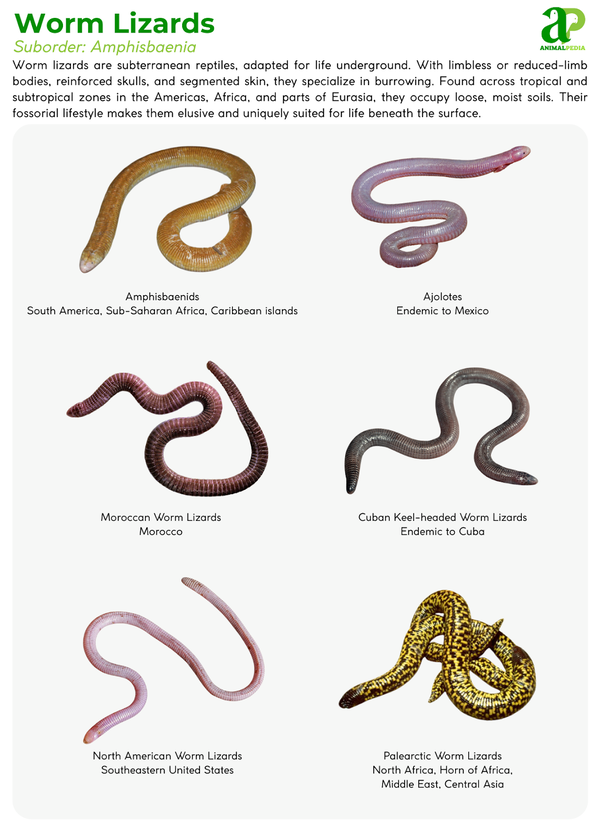
Where Do Worm Lizards Live?
Worm lizards, or amphisbaenians, inhabit specific regions across six continents. They live throughout North America, Europe, Africa, South America, the Caribbean, and Western Asia. Bipes biporus populations concentrate in Baja California, Mexico. The larger Amphisbaena alba thrives in Brazil’s Amazon rainforest and Trinidad. Blanus cinereus burrows through Spain’s Iberian Peninsula. Currently, scientists recognize over 200 species distributed across these biogeographical zones.
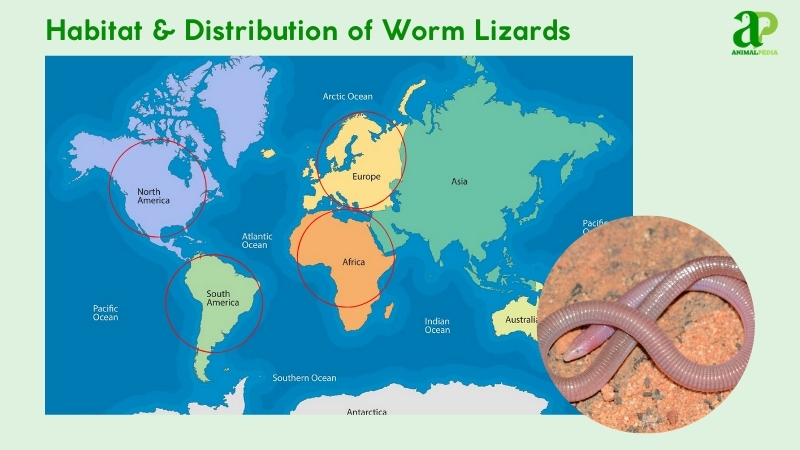
How Do Seasonal Changes Affect Their Behavior?
Worm lizards (Amphisbaenia) exhibit seasonal behavioral rhythms shaped by their environment. Their life underground is closely linked to rainfall cycles and soil conditions, especially in arid and semi-arid regions.
Worm lizards adapt their behavior across two key seasons: wet (spring/summer) and dry (fall/winter). These shifts, tied to rainfall and temperature, drive their subterranean lives.
- Wet Season (April–August): Burrowing peaks as soft soil eases tunneling. Feeding ramps up on abundant insects; mating often occurs now.
- Dry Season (September–March): Activity drops; they dig deeper to escape heat or cold. Energy conservation rules—less hunting, more resting.
These adaptations reflect their evolutionary commitment to a fossorial lifestyle, maximizing survival and reproduction beneath the surface.
What Is The Behavior Of Worm Lizards?
Worm lizards, or amphisbaenians, exhibit cryptic behaviors suited to subterranean life. These elusive reptiles, spanning over 200 species, reveal fascinating adaptations through recent studies (Meza et al., 2024).
- Feeding Habits: They ambush prey—worms, insects, small vertebrates—in tunnels. Strong jaws crush food efficiently.
- Bite & Venomous: Non-venomous; their bite grips prey, not humans. It’s harmless but firm.
- Daily Routines: Nocturnal; they burrow and rest to avoid surface heat. Activity peaks in wet seasons.
- Locomotion: Legless, they slither via scale friction. Bipedal species dig with tiny forelimbs.
- Social Structures: Solitary, they shun groups. Territories overlap without conflict.
- Communication: Vibrations signal presence. No vocalization—silence rules underground.
To grasp their world, start with their feeding habits. These define their predatory prowess and ecological niche.
What Do Worm Lizards Eat?
Worm lizards are specialized carnivores that feed primarily on soil-dwelling invertebrates. Their diet and feeding behaviors vary by age, size, and seasonal prey availability. Adapted to a subterranean lifestyle, they are among the few reptiles fully adapted for life underground.
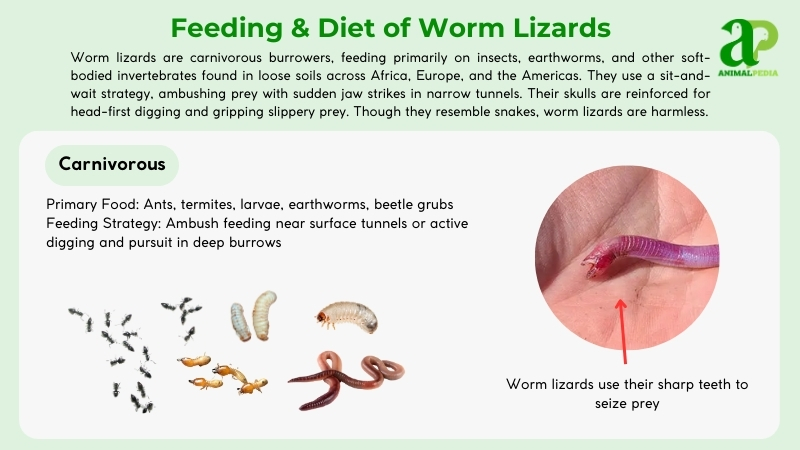
- Diet by Age
Hatchlings and juveniles consume small soft-bodied prey such as insect larvae and termites. These are easier to locate and digest in shallow soil layers. As they mature, adults feed on larger invertebrates like beetle grubs, earthworms, and ants. Their jaw strength and cranial rigidity allow them to crush tougher prey without chewing.
- Diet by Gender
Males and females consume the same prey types. However, males may forage more actively during breeding seasons due to increased energy demands. No significant differences in hunting techniques have been documented between sexes.
- Diet by Seasons
In the wet season (April–August), moist soil supports higher invertebrate activity, increasing food availability. Worm lizards hunt more frequently during this period. In the dry season (September–March), prey becomes scarce, prompting reduced activity, deeper burrowing, and extended fasting periods (Meza et al., 2024).
How Do Worm Lizards Hunt Their Prey?
Worm lizards hunt with stealth and strategy. They rely on their acute olfactory sense to detect prey beneath the soil surface. These specialized reptiles—scientifically known as amphisbaenians—primarily consume arthropods, larvae, and small invertebrates in their underground habitat.
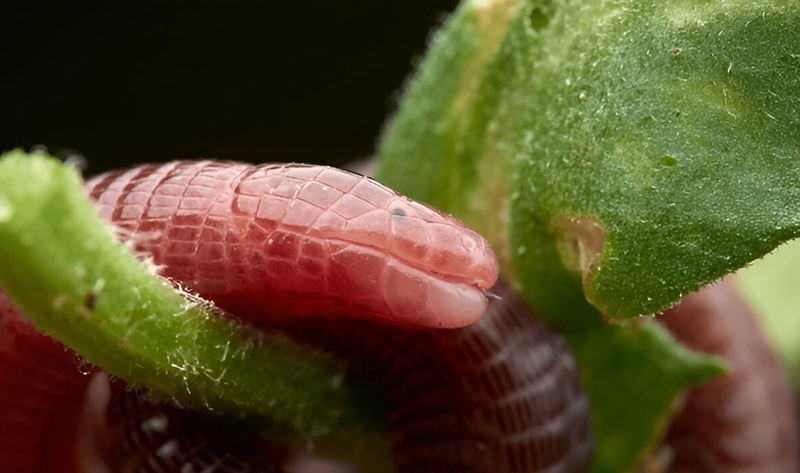
Their cylindrical bodies and keratinized scales allow efficient movement through the substrate. When hunting, worm lizards detect chemical signatures that reveal nearby prey. They track these chemical trails using their highly sensitive Jacobson’s organ.
Once prey is located, they employ a burst-and-capture technique. The worm lizard is motionless, then rapidly accelerates through the soil toward its target. Their modified dentition, featuring sharp, recurved teeth, secures struggling prey efficiently.
Their neuromuscular response time is exceptionally fast—a critical adaptation for subterranean predators. This combination of sensory acuity and physical specialization makes worm lizards formidable fossorial hunters despite their seemingly simple body plan.
Are Worm Lizards Venomous?
Worm lizards (Amphisbaenia) lack venom glands. These legless reptiles have evolved perfectly for subterranean life. Rather than producing toxins, they hunt with powerful jaws and sharp teeth, capturing soil-dwelling prey such as insects, larvae, and small invertebrates.
Are worm lizards dangerous to humans? No. Despite resembling snakes, these burrowing reptiles (amphisbaenians) pose zero threat to people. When disturbed, they retreat deeper underground instead of attacking.
Their specialized hunting techniques demonstrate evolutionary adaptation to life beneath the soil surface, where they’ve thrived for millions of years without needing venomous capabilities.
When Are Worm Lizards Most Active During The Day?
Worm lizards tend to be most active during the cooler parts of the day, such as early mornings or late evenings. They prefer to avoid the peak of the sun’s heat and are more comfortable moving around when the temperatures are milder. In hot weather, they retreat deep underground to escape the scorching heat.
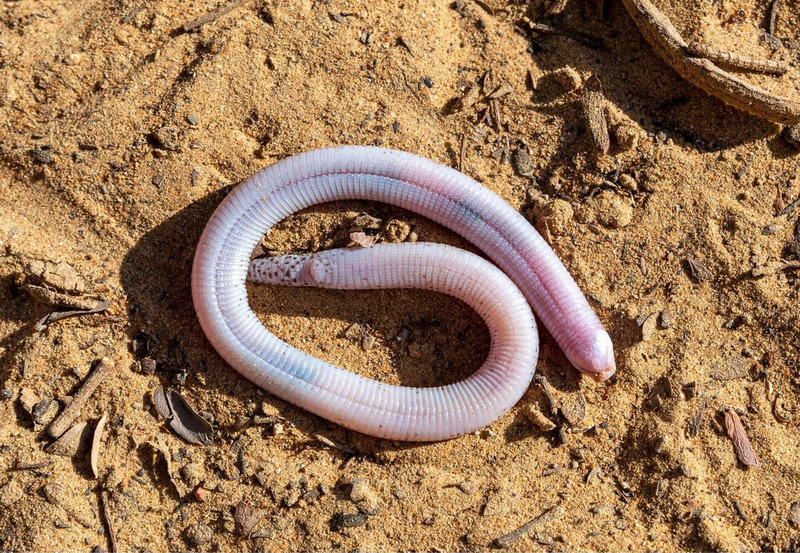
During their active hours, Worm lizards emerge from their burrows to hunt for food, mainly insects and small invertebrates. They move smoothly and purposefully as they explore their sandy or loamy habitats in search of prey.
If you happen to spot a Worm lizard during one of these active periods, you may notice its unique cylindrical body moving effortlessly through the soil.
How Do Worm Lizards Move On Land And Water?
Amphisbaenians (worm lizards) move with distinct methods across both terrestrial and aquatic environments. On land, these legless reptiles use lateral undulation—a precise side-to-side body motion — to navigate through soil and substrate. This serpentine movement mimics annelid locomotion, helping these fossorial specialists to conceal while hunting invertebrate prey. Their cylindrical bodies, with reduced scales and reinforced skulls, are perfectly suited to this subterranean propulsion method.
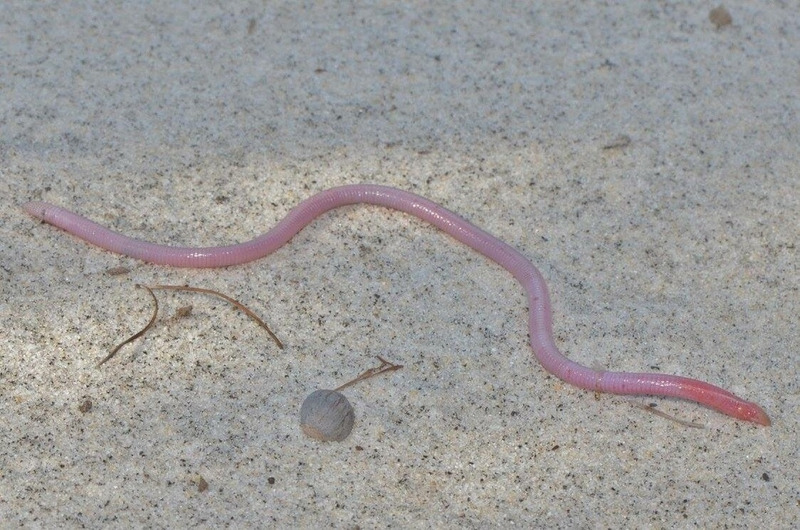
While primarily terrestrial burrowers, amphisbaenians occasionally enter water bodies. During aquatic excursions, they employ the same sinusoidal movement patterns seen on land. This swimming technique, though less refined than true aquatic reptiles, demonstrates their evolutionary adaptation across habitat boundaries.
The biomechanics of worm lizard movement reveal efficiency. Their muscular coordination allows them to maintain consistent forward momentum despite environmental resistance. This specialized locomotion enables them to thrive in microhabitats inaccessible to many other reptiles.
Amphisbaenian movement represents a prime example of convergent evolution, having developed similar movement strategies to those of snakes and earthworms despite their different evolutionary origins. Their locomotion showcases the adaptability of limbless reptiles across the diverse terrains they inhabit.
Do Worm Lizards Live Alone Or In Groups?
Amphisbaenians (worm lizards) lead solitary lives in their natural habitat. These burrowing reptiles prefer isolation rather than social groupings. They patrol their underground territories alone, hunting invertebrates and creating tunnel systems through loose soil without companionship.
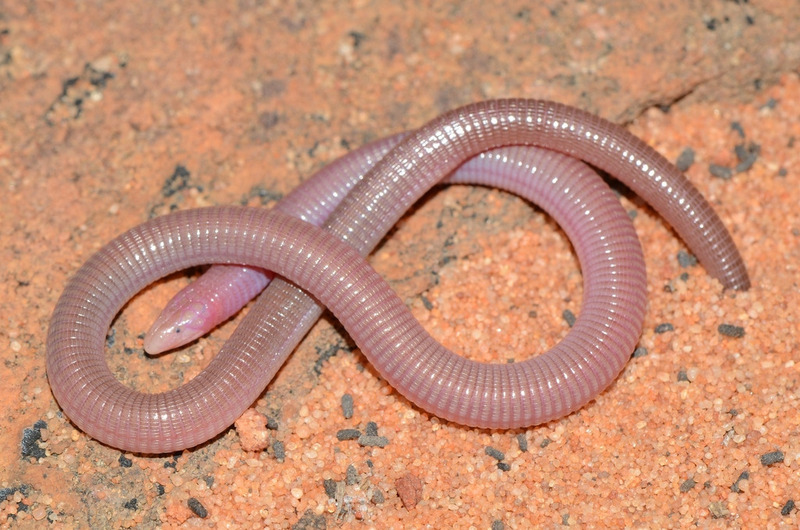
Unlike colonial reptiles, worm lizards thrive in solitude. Their specialized cylindrical bodies and reinforced skulls equip them perfectly for independent subterranean navigation. This solitary existence aligns with their low metabolic requirements and specialized feeding habits.
Solitary behavior in amphisbaenians isn’t antisocial; it’s an evolutionary adaptation. These creatures typically interact only during brief mating periods. Their self-sufficient lifestyle reflects millions of years of adaptation to underground ecosystems where group living offers few advantages.
How Do Worm Lizards Communicate With Each Other?
Worm lizards, or Amphisbaenians, communicate through minimal but effective signals. They use tactile cues, chemical secretions, and vibrational patterns to exchange information underground.
When threatened, a worm lizard retreats rapidly into its burrow, creating substrate vibrations that alert nearby conspecifics to potential danger. During mating seasons, males emit species-specific pheromones that female receptors detect even through soil layers.
Territorial boundaries are established through scent marking. Worm lizards drag their cloacal regions against tunnel walls, depositing chemical signatures that other individuals recognize and respect. This non-aggressive demarcation system prevents unnecessary confrontations in their resource-limited environment.
Research on Blanus cinereus reveals that head-bobbing serves as a dominance display during rare encounters. The annular segments of their bodies create distinct vibration patterns when rubbed against tunnel surfaces—a form of seismic communication particularly effective in their subterranean habitat.
Underground social networks develop through these subtle interaction channels, proving these limbless reptiles maintain complex ecological relationships despite their secretive lifestyle and reduced sensory systems.
How Do Worm Lizards Reproduce?
Worm lizards, amphisbaenians, reproduce by laying eggs—a process called oviparous reproduction. Over 200 species in this suborder, Amphisbaenia, follow this reproductive strategy, consistent with their reptilian ancestry.
The breeding cycle begins during spring months (April–May), coinciding with peak moisture levels. These fossorial reptiles, typically solitary burrowers, emerge briefly for mating. Males locate females through subtle substrate vibrations. Their courtship involves body coiling rather than elaborate displays. Mating occurs rapidly underground, as documented in recent herpetological studies by Meza et al. (2024).
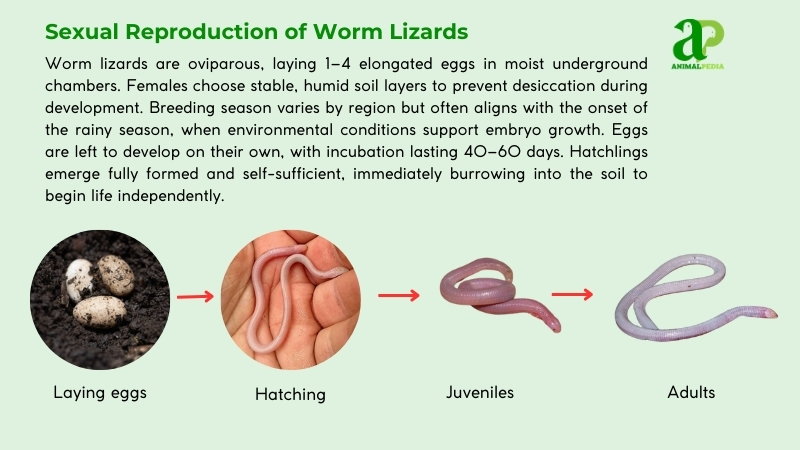
After successful copulation, females produce small clutches of 1–3 eggs. Each egg weighs between 0.2–0.4 oz (5–11 g). Females deposit these eggs in shallow subterranean chambers without further parental care. Natural soil conditions provide protection. Males depart immediately after breeding, while females briefly before abandoning the nest site. Environmental stress, particularly drought, can inhibit egg production during dry periods (Longrich et al., 2015). Incubation lasts 2–3 months, with hatchlings emerging during summer.
These young worm lizards measure 2–3 inches (5–7 cm) and show immediate independence. Growth proceeds slowly, with sexual maturity reached at 2–3 years. Species like Bipes biporus typically live for more than 10 years. Complete life history details are limited due to their secretive, underground lifestyle.
How Long Do Worm Lizards Live?
Worm lizards, or amphisbaenians, develop from hatchling to mature adult in 2-3 years. These subterranean reptiles emerge from eggs fully independent and grow slowly in their underground habitat. Research is limited due to their secretive lifestyle (Meza et al., 2024).
The average lifespan of worm lizards ranges from 10-15 years. Studies of the Mexican worm lizard (Bipes biporus) indicate that these creatures commonly live for a decade in captivity. While comprehensive data is scarce, current evidence shows no major lifespan differences between males and females. Their longevity factors include limited exposure to predators, energy-efficient behaviors, and a protected fossorial existence beneath the soil surface.
What Are The Threats Or Predators That Worm Lizards Face Today?
Worm lizards, or amphisbaenians, face mounting threats in their subterranean world. Habitat loss, climate change, and human activity imperil these elusive reptiles. Predators also stalk them across their range.
- Habitat Loss: Urban sprawl and agriculture shred their burrowing grounds. Populations shrink as soil becomes concrete (Longrich et al., 2015).
- Climate Change: Shifting rainfall dries out soils or floods tunnels. This disrupts breeding and feeding, slashing survival rates.
- Pesticides: Chemical runoff poisons prey and lizards alike. Sublethal doses weaken them, per recent ecological studies.
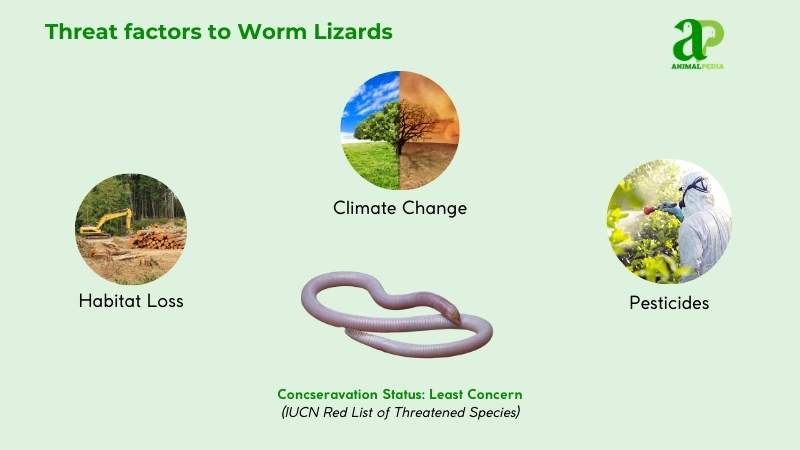
Birds of prey, like hawks, snatch them from surface forays. Mammals—foxes, weasels—dig them out. Larger reptiles, including snakes, hunt them in tunnels. Their cryptic life offers some shield, but not enough.
Humans drive the biggest blows. Deforestation in Brazil’s Amazon and urban growth in Mexico’s Baja California erode habitats for Amphisbaena alba and Bipes biporus. Pesticides from farms seep into soils, killing prey and tainting worm lizards. A 2020 study in Ecology and Evolution found tail breakage in Amphisbaena vermicularis spiked near agricultural zones, signaling stress from human encroachment (Guedes et al., 2020). Conservation lags—few species hit the IUCN Red List yet, but the clock ticks.
Are Worm Lizards Endangered?
Worm lizards, or amphisbaenians, aren’t broadly endangered across their taxonomic range. Among the 200+ species worldwide, including Bipes biporus (Mexican mole lizard) and Amphisbaena alba (white-bellied worm lizard), most lack a formal conservation status. Limited data exists because these reptiles live underground, making population assessments difficult.
The IUCN Red List provides status for select species with scientific precision. Blanus cinereus (Iberian worm lizard) is listed as Least Concern, with stable populations across Spanish and Portuguese territories. Amphisbaena alba is unlisted despite increasing habitat fragmentation. Rhineura floridana (Florida worm lizard) is approaching Vulnerable status due to rapid urban development across its limited range (IUCN, 2020). Most species are scientifically unassessed—their subterranean lifestyle shields them from comprehensive evaluation.
Population metrics are scarce in the scientific literature. Blanus cinereus maintains robust numbers, with population estimates reaching tens of thousands based on systematic surveys across the Iberian Peninsula (Salvador, 2015). Rhineura floridana population likely falls below 10,000 individuals according to Hammerson’s 2016 field research, directly correlating with habitat destruction. Amphisbaena alba persists throughout South American ecosystems, though quantitative assessments are absent—Guedes et al. (2020) documented notable resilience despite ongoing Amazon deforestation pressures.
What Conservation Efforts Are Underway?
Worm lizards (amphisbaenians) face mounting threats, driving the need for focused conservation action. The Brazilian Herpetological Society began protecting Amphisbaena alba in 2016 across the Amazon regions, prioritizing habitat preservation against rapid deforestation. Since 2018, the IUCN has tracked specific species, including the Florida worm lizard (Rhineura floridana), to halt population declines caused by expanding urban development.
Legal protections strengthen these initiatives. Brazil’s 2019 Environmental Protection Act prohibits habitat destruction in critical amphisbaenian zones, banning soil disturbance and excessive pesticide use near burrow systems. In the United States, Florida’s 2020 Wildlife Code limits development in Rhineura habitats, protecting vital sandy soil ecosystems from construction damage.
Captive breeding programs demonstrate effectiveness. The São Paulo Zoo launched reproduction efforts for Amphisbaena vermicularis in 2021, successfully producing 50 juvenile specimens by 2023, of which 30% were successfully reintroduced to restored natural habitats (Ribeiro et al., 2022). The Florida Reptile Conservation Center has bred 20 Rhineura floridana since 2017, with 15 thriving after release, according to Hammerson’s 2016 assessment updates. Organizations like Conservation International fund these initiatives, enhancing their impact.
Success stories provide evidence of progress. In Brazil, habitat restoration for Amphisbaena alba near São Paulo has tripled local population sightings since 2020. Florida’s protected zones for Rhineura recorded a 25% population increase by 2023, according to recent IUCN data. These achievements confirm that conservation succeeds when scientific research guides practical action.
Frequently Asked Questions
Can Worm Lizards Regrow Their Tails Like Some Other Reptiles?
Yes, like other reptiles, worm lizards can regrow their tails if they are lost due to predation or accidents. However, this process varies in both timing and effectiveness across different species of worm lizards.
Do Worm Lizards Have Any Natural Defense Mechanisms?
Yes, worm lizards have natural defense mechanisms. They can use their pointed scales and burrowing abilities to protect themselves. These adaptations help worm lizards evade predators and survive in their underground habitats.
Are Worm Lizards Endangered Or At Risk Of Extinction?
You’d be glad to know that worm lizards are not currently endangered or at risk of extinction. Their populations are relatively stable, and conservation efforts are in place to sustain their continued existence in the wild.
Can Worm Lizards Make Any Vocalizations Or Sounds?
Yes, worm lizards can make vocalizations. They produce subtle sounds such as hisses or low grunts. These sounds are primarily used for communication during interactions with other worm lizards or as a defensive mechanism.
Do Worm Lizards Have A Keen Sense Of Smell Or Taste?
You know, worm lizards have a keen sense of smell and taste. They rely on these senses to find food like insects and larvae. Their sharp senses help them navigate their underground habitats effectively.
Conclusion
Worm lizards represent reptiles with specialized adaptations for subterranean existence. Their cylindrical bodies and reduced limbs enable efficient burrowing, while their smooth scales and autotomy (tail shedding) provide effective defense mechanisms against predators. These amphisbaenians inhabit diverse ecosystems across Africa, South America, the Caribbean, and parts of North America and Europe.
Conservation challenges threaten these fossorial reptiles primarily through habitat destruction, agricultural expansion, and urbanization. Their secretive nature makes population assessment difficult, further complicating protection efforts.
The future of these specialized reptiles depends on habitat preservation, continued research, and public education about their ecological significance. By implementing targeted conservation strategies, we can ensure the survival of these extraordinary burrowing reptiles for generations to come.





